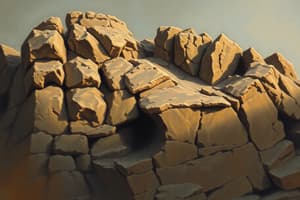Podcast
Questions and Answers
Which type of sedimentary rock contains clasts?
Which type of sedimentary rock contains clasts?
- Clastic (correct)
- Chemical
- Igneous
- Biologic
What is the size range of clay and silt in clastic sedimentary rocks?
What is the size range of clay and silt in clastic sedimentary rocks?
- Less than 1/16 mm (correct)
- Between 1/16 and 1/8 mm
- Greater than 2 mm
- Between 1/16 and 2 mm
What is the composition of clastic sedimentary rocks divided into?
What is the composition of clastic sedimentary rocks divided into?
- Igneous, metamorphic, and sedimentary
- Clay/silt, sand, and gravel (correct)
- Clastic, chemical, and biologic
- Granite, basalt, and limestone
What is the size range of sand in clastic sedimentary rocks?
What is the size range of sand in clastic sedimentary rocks?
What is the size range of gravel in clastic sedimentary rocks?
What is the size range of gravel in clastic sedimentary rocks?
Flashcards
Clastic Sedimentary Rock
Clastic Sedimentary Rock
A type of sedimentary rock formed from fragments (clasts) of pre-existing rocks and minerals.
Clast Composition
Clast Composition
Particles, minerals, or rock fragments in clastic rocks, categorized into clay/silt, sand and gravel, based on size.
Size of Clay and Silt
Size of Clay and Silt
Less than 1/16 mm. These are the finest-grained components of clastic rocks, often forming mudstones or shales.
Size of Sand
Size of Sand
Signup and view all the flashcards
Size of Gravel
Size of Gravel
Signup and view all the flashcards
Study Notes
Clastic Sedimentary Rocks
- Conglomerate, a type of sedimentary rock, contains clasts, which are fragments of pre-existing rocks.
- Clastic sedimentary rocks are classified based on the size of their clasts, with clay being the smallest (less than 0.0625 mm in diameter).
- Silt, another clast size, ranges from 0.0625 mm to 2 mm in diameter.
- Clastic sedimentary rocks are also divided into three composition categories: conglomerate (large clasts), sandstone (sand-sized clasts), and shale (clay-sized clasts).
- Sand, a common clast size, ranges from 2 mm to 0.0625 mm in diameter.
- Gravel, the largest clast size, consists of particles larger than 2 mm in diameter.
Studying That Suits You
Use AI to generate personalized quizzes and flashcards to suit your learning preferences.




